Knowde Enhanced TDS
Identification & Functionality
- Chemical Family
- Food Ingredients Functions
- Ingredients
- Sunflower Oil, Maltodextrin, Gelatin, Salt, Trisodium Phosphate
- Technologies
- Product Families
- Chemical Structure
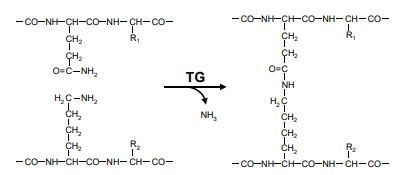
- Origin
Non-pathogenic microorganisms (GRAS status)
Features & Benefits
- Labeling Claims
- Food Ingredients Features
- Properties
- Increases mechanical strength
- Improves bite
- Covalently links proteins
- Improves temperature resistance
Applications & Uses
- Markets
- Applications
- Food & Nutrition Applications
- Applications
- Portion controlled fish medallions
- Standardization and binding of small fish filets and pieces
- Dosage & Application - Meat
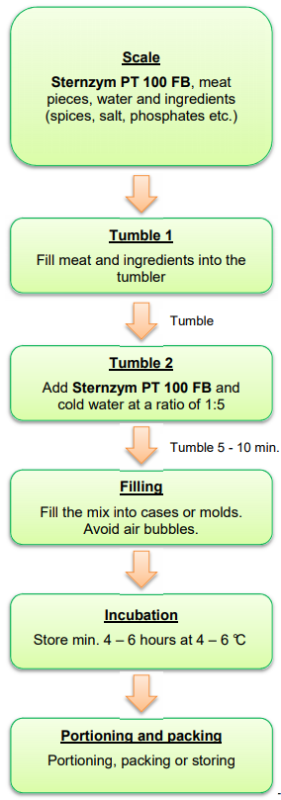
Dosage of Sternzym PT 100 FB is 700 – 1,000 g per 100 kg of raw material.
Salt, phosphate and spices should be scaled according recipe and taste.
The typical dosage of up to 3% sodium chloride and/or 0.3% phosphate improves binding in of the meat pieces.
Add phosphate, salt, spices etc to meat pieces and mix thoroughly until all surfaces are evenly covered.Add Sternzym PT 100 FB and ice cold water in a ratio of 1g enzyme compound per 4g water to the tumbler 10 minutes before the end of the whole tumbling process.
Fill everything into artificial casing or molds of desired form.
Keep the casings at least four to six hours (depends on dosage and temperature) refrigerated at about 5°C.
The optimal dosage depends greatly on process conditions and the quality of the starchy material and may therefore deviate from the suggested dosage. Finding the optimal dosage for each individual process is a matter for the customer.
- Dosage & Application - Fish
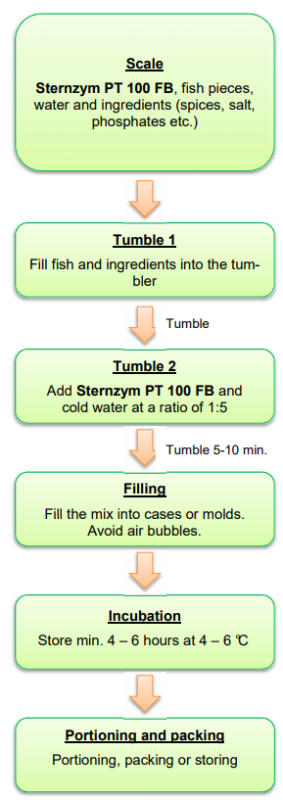
Dosage of Sternzym PT 100 FB is 700 – 1,000 g per 100 kg of raw material.
Salt, phosphate and spices should be scaled according recipe and taste.
The typical dosage of up to 3% sodium chloride and/or 0.3% phosphate improves binding in of the fish or pieces.
Add phosphate, salt, spices etc to fish pieces and mix thoroughly until all surfaces are evenly covered.Add Sternzym PT 100 FB and ice cold water in a ratio of 1g enzyme compound per 4g water to the tumbler 10 minutes before the end of the whole tumbling process.
Fill everything into artificial casing or molds of desired form.Keep the casings at least four to six hours (depends on dosage and temperature) refrigerated at about 5°C.
The optimal dosage depends greatly on process conditions and the quality of the starchy material and may therefore deviate from the suggested dosage. Finding the optimal dosage for each individual process is a matter for the customer.
Properties
- Appearance
- Powder
- Chemical Properties
- Typical Properties
- Microbiological Values
- Nutritional Information
- Nutritional Data
Description Value Unit/100g Energy 907 kJ Energy 217 kcal Fat 1.0 g of which: saturated fatty acids (FA) 0.05 g Carbohydrates 9.5 g of which: Sugar 0.7 g Protein 42.4 g Salt (Sodium x 2.5) 37.0 g Sodium 14.8 g
| Value | Units | Test Method / Conditions | |
| Arsenic Content | max. 3 | mg/kg | AAS |
| Cadmium Content | max. 0.5 | mg/kg | AAS |
| Lead Content | max. 5 | mg/kg | AAS |
| Loss on Drying | max. 14 | g/100g | §64 LFGB-2h 130°C |
| Mercury Content | max. 0.5 | mg/kg | AAS |
| Value | Units | Test Method / Conditions | |
| Transglutaminase | 90 - 110 | u/g | Hydroxamate Assay |
| Value | Units | Test Method / Conditions | |
| Escherichia coli | max. 10 | cfu/g | §64 LFGB |
| Salmonella | Negative | cfu/25g | §64 LFGB |
| Total Plate Count | max. 50000 | cfu/g | §64 LFGB |
| Value | Units | Test Method / Conditions | |
| Energy | 907 | kJ/100 g | — |
| Fat Content | 1 | g/100g | — |
| Saturated Fatty Acids | 0.05 | g/100g | — |
| Carbohydrates | 9.5 | g/100g | — |
| Sugar | 0.7 | g/100g | — |
| Protein | 42.4 | g/100g | — |
| Salt (Sodium x 2.5) | 37 | g/100g | — |
| Sodium Content | 14.8 | g/100g | — |
Regulatory & Compliance
- Certifications & Compliance
- Regulatory Information
Allergen Information: contains the allergen milk and lactose according to Regulation 1169/2011/EG, Annex II
Health Information: The products are suitable for human consumption if used accordingly to recommendations and officially allowed to be sold within Germany and the EU. The product is food grade and conforms with the current european food law.
GMO: This product is not a genetically modified organism (GMO), nor does it contain any GMO or any recombinant DNA.
All the non-enzymatic constituents of the product (e.g. carriers, stabilizing agents, free-flowing agents etc.) originate from non-genetically modified sources. Due to the ubiquitous presence of GMO organisms, absence of minor traces of GMO material cannot be guaranteed, but in any case, the content of unintentionally present GMO material will be below 0.9%, in accordance to EU guidelines 1830/2003 and 1829/2003. The product is used as processing aid in food manufacturing processes, and therefore labeling is not required in the EU. National regulations must be observed.Product suitability:
Yes No Vegetarian X Vegan X BSE/TSE Information: The mentioned product does not represent a BSE (Bovine Spongiform Encephalopathy) and/or TSE (Transmissible Spongiform Encephalopathy) risk.
Irradiation: Neither the product nor its ingredients have been treated with ionizing radiation according to Directive 1999/2/EC and 1999/3/EC
Nanoparticles: The product does not contain ingredients in the form of engineered nanomaterials as defined in Regulation (EU) 2015/2283.
Contamination/Residues: The product complies with: Regulation (EC) No 396/2005 and its amendments regarding maximum levels for pesticide residues in foodstuffs. Regulation (EC) No 1881/2006 and its amendments regarding especially maximum levels for heavy metals, mycotoxins, dioxins and PCB in foodstuffs.
Conformity of the Packaging: The packaging material complies with the provisions of Regulation (EC) No 1935/2004 and Regulation (EU) No 10/2011.
Technical Details & Test Data
- Enzyme Activity and Stability Data
Activity:
- Transglutaminase: 100 u/g (pH 7.0, 37°C)
- pH optimum: 6.0 – 7.0
- Temperature optimum: 50°C
Fig. 1: Effect of the temperature on the activity of Sternzym PT 100 CAS (pH)
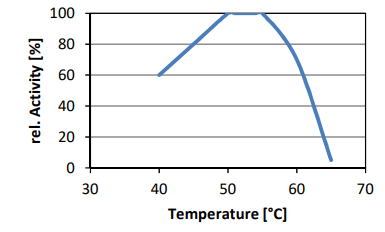
Fig. 2: Effect of the temperature on the Stability at pH 7 (10 min).
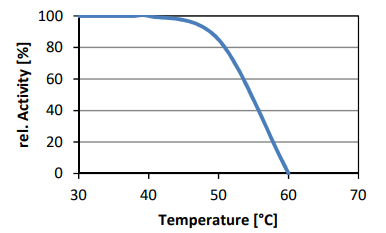
Fig. 3: Effect of the pH on the activity of Sternzym PT 100 CAS (37°C)
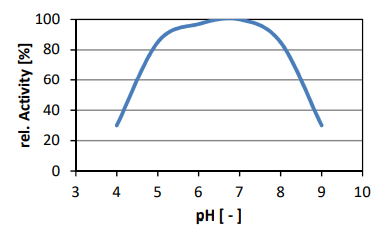
Safety & Health
- Safety Precautions and Handling
Enzymes are proteins. Inhalation of dust or aerosols may induce sensitization and cause allergic reactions in sensitized individuals. Prolonged contact with some enzymes may irritate the skin, eyes and mucous membranes. The product may create easily inhaled aerosols if splashed or vigorously stirred. Spilled product may dry out and create dust. Spilled material should be flushed away with water. Avoid splashing. Left over material may dry out and create dust. Wear suitable protective clothing, gloves, eye and face protection, and wash contaminated clothes. A Material Safety Data Sheet is supplied with all products for further information on how to handle the product safely.
Packaging & Availability
- Packaging
- Cardboard box with 4x5 kg aluminum bags, 20 kg net - Meat & Fish
- 10 x 1 kg MAP bags in carton
Storage & Handling
- Storage & Stability
When kept cool and dry in original, sealed packaging activity loss is less than 15% in 12 months The product is susceptible to oxidation and should be used quickly after opening of the package.







